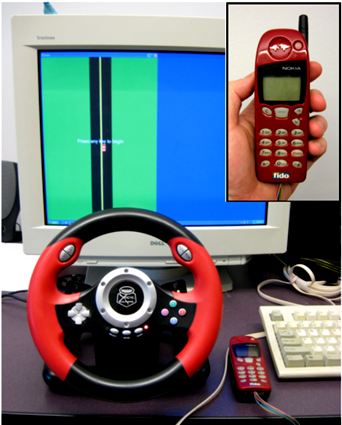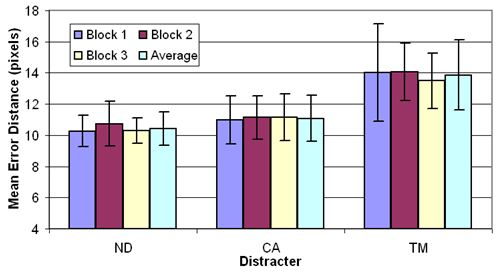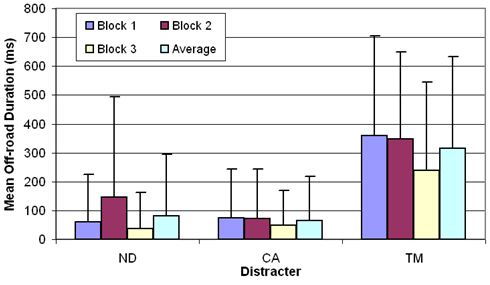Teather, R. J., & MacKenzie, I. S. (2013). Effects of user distraction due to secondary calling and texting tasks. Proceedings of the International Conference on Multimedia and Human-Computer Interaction - MHCI 2013, pp. 115.1-115.8. Ottawa, Canada: International ASET, Inc. [PDF]
Effects of User Distraction Due to Secondary Calling and Texting Tasks
Robert J. Teather & I. Scott MacKenzie
Dept. of Computer Science and EngineeringYork University, Toronto, Canada
rteather@cse.yorku.ca; mack@cse.yorku.ca
Abstract - We conducted a study of user distraction using a simple driving game controlled by a steering wheel. Steering performance was compared in three conditions, two using distracter tasks and one without distractions. One distracter simulated answering calls on a mobile phone. The second simulated sending short text messages using a phone keypad. Both distracters were performed during the primary steering task, necessitating division of attention between two unrelated tasks. Results indicate that the text messaging distracter significantly degraded steering performance. On average, distance from the center of the "driving lane" increased by about 33%, compared to the no distracter condition. The call answering distracter resulted in about a 6% increase. Deviation during text messaging improved upon completion of a message.Keywords: Attention splitting, driving while texting, distracter tasks.
1. Introduction
Handheld devices are common in today's fast moving and highly mobile world. A troubling trend is the use of these devices while driving, especially mobile phones. Using these devices while driving divides the attention between unrelated tasks, degrading driving ability and increasing the risk of traffic collisions (Violanti, 1997). Statistics suggest up to a 23× increase in the risk of a crash while texting (Richtel, 2009).Mobile phones now provide a variety of possible distractions which may degrade driving performance. Text messaging (texting), in particular, is now ubiquitous. Despite the availability of efficient techniques, texting requires considerable visual attention and cognition. Since speech is more natural, texting a phrase, rather than speaking it, requires more time and cognitive effort.
As handheld device increases, it is important to understand how attention splitting affects drivers. Mobile phone use while driving not only increases the risk of accidents (Violanti, 1997), but drivers tend to be unaware of their degraded performance (Lesch and Hancock, 2004). Consequently, driving while using a mobile phone is already banned in some jurisdictions. Hands-free headsets are often allowed, due to the perhaps mistaken (Redelmeier and Tibshirani, 1997) belief that they are safer.
Nevertheless, many people continue to use mobile phones while driving – this is easily observed by watching drivers at busy intersections. Thus, a primary goal in the design of in-vehicle interfaces is to minimize user distraction caused by the interface; this necessitates a better understanding of distraction.
We present a study examining these issues relating to mobile phone use during a driving. Using a simple 2D driving game, participants steered a virtual car while performing secondary distracter tasks. The distracters simulated answering calls and texting with a mobile phone. Our objective was to quantify relative difference in the impact of these distracters on steering performance.
2. Related Work
2.1. In-vehicle Information Systems and Visual Attention
Previous research has found visual attention a primary concern in in-vehicle interface design. Bach et al. (2008) investigated tactile, touch, and gesture-based in-vehicle interfaces. Their goal was to determine which required the least visual attention. They compared a standard car stereo interface (tactile condition, using knobs and buttons), a touch-screen interface, and a gesture-based interface using the touch-screen as a "drawing canvas". The drawing canvas used gestures to afford the same functionality as the other two interfaces. Their experiment used both real and simulated driving scenarios. Gesture interaction reduced, but did not eliminate, the need for glancing at the secondary interface. Touch was most efficient, but also required the most visual attention, which may explain why it afforded the fastest task completion. Ultimately, the results showed that the type of interface affects driving performance, with the worse interfaces resulting in more driving errors.
Salvucci et al. (2007) examined distraction while drivers selected media on an iPod while driving a simulator. The iPod was mounted in a hands-free holder, near the steering wheel to reduce glancing away from the road. Selecting songs and videos significantly increased the mean deviation from lane centre. Playing videos also significantly reduced driving speed.
A similar approach by González et al. (2007) was to align the in-vehicle information system controls with the users' hands. Like other work (Salvucci et al., 2007), they positioned the user interface where the user is looking – above the steering wheel. The motivation was to reduce glancing away from the road and to reduce the time the hands are off the wheel. Using a touch-sensitive pad on the steering wheel, users selected GPS destinations with several thumb-based techniques, including a linear keyboard and EdgeWrite stroke recognition (Wobbrock et al., 2003). EdgeWrite resulted in fewer driving errors, but was not compared to a condition without a secondary task, or against commonly techniques such as voice recognition. Consequently, it is difficult to say if this technique reduces distraction relative to existing practice.
The results of these studies indicate that visual attention on the secondary display needs to be dramatically reduced to mitigate the impact on driving performance. Systems such as blindSight (Li et al., 2008) augment mobile input with auditory cues to reduce the visual attention required to perform complex tasks with mobile phones. The authors found that a visual interface resulted in fewer errors and required fewer keystrokes to perform tasks. Of the two eyes-free conditions, phone operation near the ear and using the thumb was superior to holding the phone in the hand and using the index fingers to press keys. They evaluated the thumb condition in a driving simulator using the eyes-free system to enter phone numbers or calendar appointments. Participants preferred blindSight to a commercially available "eyes-on" system. However, driving performance was not reported.
2.2. Driver Distraction
Researchers have looked beyond visual attention as the sole cause of reduced driving performance. Redelmeier and Tibshirani (1997) found that hands-free interfaces did not help avoid traffic collisions compared to hand-held phone use. Thus, the cognitive load of conversation is also a factor in driver distraction. Schneider and Kiesler (2005) proposed to avoid distracting calls entirely. If traffic conditions are unfavourable, a caller is unaware, while a passenger in the car can cease talking, allowing the driver to focus. They found that drivers who did not engage in distracting conversation had fewer collisions than those that did. They suggest providing callers with information about a driver's traffic situation, allowing callers to choose relatively safer times to call.
Other researchers have examined modelling driver distraction and visual attention using Card et al.'s Keystroke-Level Model (Pettitt et al., 2007) and the ACT-R framework (Salvucci et al., 2005). Both projects focus on predicting driver distraction with a given system. The models, which were experimentally verified, use basic components such as key-presses and visual glances to model interaction. Ultimately, a revised ACT-R model – called Distract-R – was more accurate for small-scale tasks, but the KLM-based model worked well for larger, more complex tasks (Pettitt et al., 2007).
3. Distracter Tasks
It is likely that performing two tasks simultaneously will degrade performance in both tasks. It is also likely that the primary task performance degradation is proportional to the cognitive load or visual attention required of the secondary task; simple secondary tasks should not impact performance as much as complex ones. Hence, we hypothesize that different distracter tasks will degrade steering performance to different degrees. To test this hypothesis, we consider two distracter tasks:
- Call Answering Distracter – answering a mobile phone while steering. This required a small
amount of visual attention.
- Text Messaging Distracter – sending text messages with a mobile phone while steering. This requires more visual attention.
The text messaging distracter is similar to Bach et al.'s (2008) stereo control task in that users can feel for the correct keys, but may need to look at the device to verify actions. However, we expect that texting will require more visual attention than stereo system control. The call answering distracter is similar to their gesture-based interface, as both require relatively little visual attention. In the following section, we describe an experiment examining the relative performance degradation in a simulated steering task in the presence of these two distracter tasks.
4. Method
4.1 Participants
Twelve participants took part in the study. Ages ranged from 22 to 31 with a mean of 25.8 years. Nine were male. All were students at the local university and were recruited by in-person request.
4.2. Apparatus
4.2.1. Hardware
The experiment was conducted on a PC using an Intel Pentium 4 processor, running at 2.4 GHz, with 512 MB of RAM. The computer used integrated graphics. A Section 7 Xtreme Gaming steering wheel controlled the position of a car displayed on the screen. The steering wheel was connected via USB. It included two foot-pedals, which were not used. Steering wheel vibration was activated when the car approached the edge of the road.
A Nokia 5190 mobile phone was used for the call answering and text messaging distracters. The phone keypad was connected to the computer via a PS/2 keyboard. Each phone key was wired to a key inside the keyboard; hence the mobile phone keypad effectively issued key press events. The mobile phone was placed between them. The relative positions of the equipment are seen in Fig. 1.
Fig. 1. Apparatus including the monitor, steering wheel, keyboard, and mobile phone. Inset: Close-up of the mobile phone used in the experiment.
4.2.2 Software
The software was written in C# and used Microsoft's DirectInput to detect steering wheel motion. We used a simple 2D driving game depicting an overhead view of a road (Fig. 2a). A small car (32 × 55 pixels) was displayed, initially centred in the right lane. The car's vertical position never changed, while its horizontal position was controlled by the steering wheel. The road scene advanced downward at 312.5 pixels per second, corresponding to a driving speed of approximately 90 km/h. Speed was held constant to simplify the experimental design. Our goal was not to elicit realistic driver responses, such as the ability to accommodate driving to the circumstances. Rather, we were interested in performance differences purely due to the distracter tasks in a controlled setting.
The road curvature was generated with a weighted random walk algorithm. Road curve direction was randomized and weighted by the x position of the current segment. This produced a road that would generally stay near the middle of the screen, while requiring the user to make slight course adjustments typical of steering a car along a highway. Fig. 2a depicts a typical segment of the road.
The distracter task windows appeared to the right of the main task window; see Fig. 2b and Fig. 2c. The text messaging distracter is shown in greater detail in Fig. 2c, as it was more complex. Fig. 2 depicts the distracters larger than they actually appeared in the experiment.
4.3. Procedure
Participants were seated at the steering wheel and were given one minute of practice with each distracter to familiarize them with the wheel control, the steering task, and the distracters.
During the experiment, participants were instructed to keep the car near the right lane centre. The steering wheel vibrated if the car came within 5 pixels of, or left, the road. This provided immediate haptic feedback about steering performance. Each block lasted five minutes, during which participants steered the car while performing the specified distracter tasks. They were instructed to focus primarily on steering, as during real driving. At the end of each block, the software paused until a key was pressed to start the next block. The baseline "no distracter" condition used only the steering task. In the distracter conditions, a distracter event occurred randomly every 2.5 to 10 seconds after the previous event was completed. Details for each distracter task are outlined below.
A call answering distracter event was initiated with a telephone ring sound. At the same time, the caller was identified in the distracter window, see Fig. 2b. There were two classes of calls, answer and reject, decided randomly for each call. Half were answered, and half were rejected. Participants were instructed to accept calls from "Home" and reject calls from "Work". For the answer-class calls, participants answered the call, read aloud a brief displayed phrase, then terminated the call. Calls were answered and terminated by pressing the large central button on the mobile phone. The rejection-class calls were rejected with the "C" button located at the top left of the keypad (see Fig. 1, inset). Including this answer/reject decision was designed to require a small amount of cognitive load and visual attention, while remaining consistent with typical mobile phone usage. Incorrectly cancelling an answer-class call or answering a reject-class call was counted as a mistake.(a) (b)
(c)
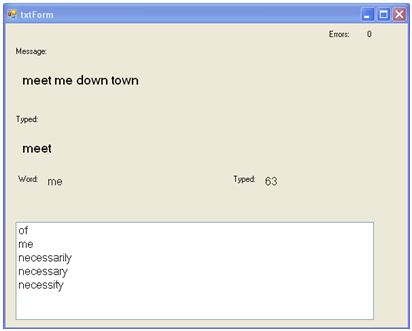
Fig. 2. Screensnaps. (a) The main window (clipped vertically to save space). The steering wheel controlled the horizontal position of the car. (b) The call answering distracter. (c) The text messaging distracter.
A text messaging distracter was initiated with a tone simulating an incoming message and a phrase simultaneously appearing in the distracter window (Fig. 2c). Participants then typed the phrase using the mobile phone keypad using a variation of T9 disambiguation with word prediction. As the participant pressed keys, up to five candidate words were displayed in the word list at the bottom of the window. For example, typing in "63" could disambiguate to "of" or "me". However, with prediction, this could also map to "necessarily", "necessary", etc. Words were ordered by frequency in English. The currently selected word was changed by pressing arrow keys on the phone keypad. Upon reaching the desired word, "0" selected and inserted the word, followed by a space character. No correction facility was provided. Upon completing the message, the timer was restarted to prepare for the next distracter event. The phrases mimicked typical things one might text while driving, such as "picking up some milk", "traffic is bad", and so on. Twenty such phrases were used.
4.4. Design
The experiment employed a 3 × 3 within-subjects design. The independent variables were distraction type (counterbalanced according to a Latin square) and block (numbered 1 through 3). Distraction type had three levels:
- ND – no distracter
- CA – call answering distracter
- TM – text messaging distracter
The dependent variables for the steering task were error distance, number of "off-road" events (how often the car left the road), and the duration of off-road events. Error distance was measured in pixels as the lateral distance between the car and the lane centre. (Note that 1 pixel ? 0.05 m, given the car and lane geometry used.) Off-road events were counted with durations measured in milliseconds.
Additional dependent variables for the distracter tasks were measured. For the call answering distracter, we measured participant reaction time as the time from the sound to the participant answering or cancelling the call. Performance for the text distracter was measured as the number of errors using minimum string distance (Soukoreff and MacKenzie, 2001).
Note that the measures for the secondary tasks were considered less important than those for the steering task. Our main interest in recording these was to determine if participants became significantly better at performing the distracter tasks over a period of 15 minutes. This could indicate that, with practice, drivers may become better at simultaneously performing secondary tasks while driving.
5. Results and Discussion
Results for each dependent variable were analysed using a repeated-measures analysis of variance.
5.1. Steering Performance
5.1.1. Error Distance
Error distance was measured as the mean distance (in pixels) from the lane centre to the car centre. The mean error distance was 10.4 pixels for the ND condition (SD = 1.1 pixels). This increased by 6.3% in the CA condition (mean = 11.1 pixels, SD = 1.4) and by 33.0% in the TM condition (mean = 13.9 pixels, SD = 2.3). The differences were significant (F2,11 = 22.6, p < .001). Tukey-Kramer multiple comparisons revealed that the text messaging distracter resulted in significantly higher error distances than either the no distracter or call answering distracter conditions (p < .001), which were not significantly different. Block did not have a significant effect on error distance, (F2,11 = 1.94, p > .05); participants' steering performance did not improve over time. Fig. 3 shows mean error distance per block. The difference between the distracters is likely due to the difference in visual and cognitive demand. The TM distracter required greater visual attention than the CA distracter. The only visual attention required by the CA distracter was to determine if a call should be answered or rejected. This message was beside the main window, so a single glance was sufficient to determine if the call should be answered or not. Participants could likely find the handset without even looking to answer/reject the call.
While entering a text message, participants had to visually attend to three things: the main steering task, the message window (to review message progress) and the mobile phone keypad. Participants with limited text messaging experience were observed to spend more time looking at the keypad.
Fig. 3. Mean error distance by distracter type and block. Error bars show ±1 SD.
Fig. 4 compares error distance over time of a typical block of the CA (Fig. 4a) and TM (Fig. 4b) conditions. This figure shows (smoothed) absolute error distance from lane centre as a function of time, and when various events occurred. Error distance increases immediately following incoming calls (Example "A"), and decreases after the call was answered (Example "B"). Similar behaviour is seen in the TM distracter. Note that due to the length of the messages sent (≈15 characters on average), fewer messages were completed in a 5-minute block than calls answered.
(a)
(b)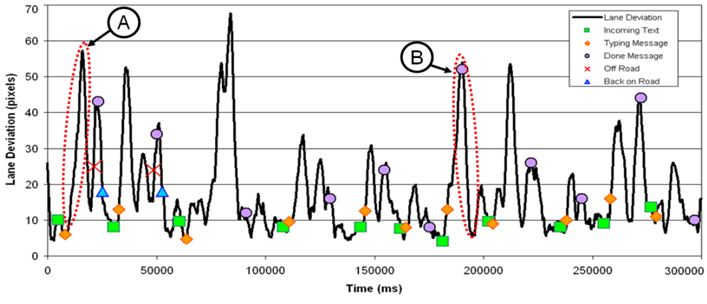
Fig. 4. Absolute error distance and events over time for representative blocks for (a) the call answering distracter and (b) the text messaging distracter. Lane deviation was smoothed with a 100-point moving average, and is given in pixels. Example A shows increasing error while attending to a distracter task; Example B shows falling error after handling a distracter task.
The mean error distance for Fig. 4a is 9.5 pixels. The error distance is clearly much higher in the TM distracter condition depicted in Fig. 4b, with a mean of 17.7 pixels. The average off-road duration for that block was about 1 second. Both blocks were performed by the same participant.
5.1.2. Off-Road Events
Off-road events occurred when the car centre passed either edge of the road. There were 8 off-road events in the ND condition, 9 in the CA condition, and 38 in the TM condition. So, without distracters, off-road events occurred once every 22.5 minutes, on average. While answering calls, off-road events occurred roughly once every 20 minutes. While sending text messages, off-road events occurred roughly once every 4.7 minutes. Distracter type had a significant main effect on off-road events (F2,11 = 9.57, p < .05). Tukey-Kramer multiple comparisons revealed that the TM distracter resulted in significantly more off-road events than either of the other two conditions (p < .05), which were not significantly different from each other. Block did not have a significant effect on off-road events (F2,11 = 1.82, p > .05), suggesting steering did not improve over time.
Obviously, the number of off-road events was high, compared to real driving. This was a by-product of the simulator's lane geometry and speed which were chosen to elicit performance differences between the distracter tasks. The steering wheel also lacked the sensitivity and feedback of a real steering wheel; a real car provides superior haptic and auditory feedback. The haptic feedback in our experiment was very simple (on or off). For real driving, while approaching the edge of the road, rumble strips and gravel provide varying degrees of haptic feedback through the mechanical steering column. Similarly, one can hear the sound of the wheels touching rumble strips. Our driving game did not employ audio feedback in this fashion. Thus, it was more difficult to sense when approaching the road edge – especially without looking. The TM distracter clearly required more visual attention, as reflected by its worse performance.
Second, the cost of an off-road event in our game was low relative to reality, where an off-road event can result in a fatal crash. In the absence "life or death" motivation, participants may have focused more on the distracter task than intended, despite the instructions given.
5.1.3. Duration of Off-Road Events
Distracter had a significant effect on the duration of off-road events, (F2,11 = 8.97, p < .05). However there was no block effect (F2,11 = 2.53, p > .05), indicating that performance did not improve over time. However, off-road event durations decreased slightly by the final block. It is possible that with additional testing, performance may improve. The average off-road durations are summarized in Fig. 5.
Fig. 5. Average off-road duration for each distracter by block. Error bars show ±1 SD.
5.1.4. Learning Effects
We were surprised that steering performance did not improve over time. Two possible explanations come to mind. First, as most (all but two) of the participants drive on a regular basis, they are already "experts" at the steering task. They were able to quickly learn and adapt to the differences between our simulated driving and real driving. The game is actually far simpler than real driving so the steering task was perhaps too easy. Second, participants gradually lost interest in the task. Several mentioned that the ND condition was "hypnotic" after a few minutes. This may have offset improvements due to practice.
5.2. Distracter Performance
We were also interested if distracter performance improved with practice, e.g., at the expense of steering performance. For the Call Answering Distracter, the mean reaction time to an incoming call was 2.7 s (SD = 1.3 s). ANOVA revealed that participant performance did not significantly improve with subsequent blocks with either distracter (F2,33 = 0.05, ns). The error rate for the texting distracter was about 1.5% using the minimum string distance (Soukoreff and MacKenzie, 2001).
6. Conclusions
Our results indicate that different distractions result in varying degrees of performance degradation. Simulated texting consistently resulted in worse performance than answering simulated calls. Although we used a simple driving game, these results are expected to hold – at least, in a relative sense – in more complex simulators and even real driving. We believe that this research can assist and motivate designers of in-vehicle devices to produce interfaces that minimize visual attention and cognitive load.
References
Bach, K. M., Jæger, M. G., Skov, M., B. and Thomassen, N. G. (2008). You can touch, but you can't look: Interacting with in-vehicle systems. "Proceedings of the ACM Conference on Human Factors in Computing Systems - CHI 2008". New York, ACM: 1139-1148.
González, I. E., Wobbrock, J., O., Chau, D. H., Faulring, A. and Myers, B., A. (2007). Eyes on the road, hands on the wheel: Thumb-based interaction techniques for input on steering wheels. "Proceedings of Graphics Interface 2007". Toronto, CIPS: 95-102.
Lesch, M. F. and Hancock, P. A. (2004). Driving performance during concurrent cell-phone use: Are drivers aware of their performance decrements? "Accident Analysis & Prevention" 36(3): 471-480.
Li, K., A., Baudisch, P. and Hinckley, K. (2008). Blindsight: Eyes-free access to mobile phones. "Proceedings of the ACM Conference on Human Factors in Computing Systems - CHI 2008", New York, ACM: 1389-1398.
Pettitt, M., Burnett, G. and Stevens, A. (2007). An extended keystroke level model (KLM) for predicting the visual demand of in-vehicle information systems. "Proceedings of the ACM Conference on Human Factors in Computing Systems - CHI 2007". New York, ACM: 1515-1524.
Redelmeier, D. A. and Tibshirani, R. J. (1997). Association between cellular telephone calls and motor vehicle collisions. "New England Journal of Medicine" 336(7): 453 - 458.
Richtel, M. (2009). In study, texting lifts crash risk by large margin. "The New York Times", July 28, 2009 edition.
Salvucci, D., D., Markley, D., Zuber, M. and Brumby, D. P. (2007). iPod distraction: Effects of portable music-player use on driver performance. "Proceedings of the ACM Conference on Human Factors in Computing Systems - CHI 2007". New York, ACM: 243-250.
Salvucci, D., D., Zuber, M., Beregovaia, E. and Markley, D. (2005). Distract-R: Rapid prototyping and evaluation of in-vehicle interfaces. "Proceedings of the ACM Conference on Human Factors in Computing Systems - CHI 2005". New York, ACM: 581-589.
Schneider, M. and Kiesler, S. (2005). Calling while driving: Effects of providing remote traffic context. "Proceedings of the ACM Conference on Human Factors in Computing Systems - CHI 2005". New York, ACM: 561-569.
Soukoreff, R. W. and MacKenzie, I. S. (2001). Measuring errors in text entry tasks: An application of the Levenshtein string distance statistic. "Extended Abstracts of the ACM Conference on Human Factors in Computing Systems - CHI 2001". New York, ACM: 319-320.
Violanti, J. M. (1997). Cellular phones and traffic accidents. "Public Health" 111(6): 423-428.
Wobbrock, J. O., Myers, B. A. and Kembel, J. A. (2003). EdgeWrite: A stylus-based text entry method designed for high accuracy and stability of motion. "Proceedings of the 16th Annual ACM Symposium on User Interface Software and Technology - UIST 2003". New York, ACM: 61-70.
